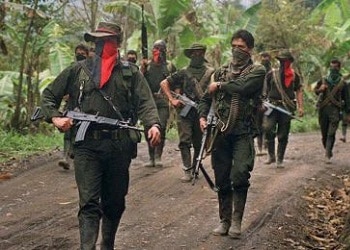Drug trafficking, battles between state forces and armed groups, extortion and illegal gold mining have transformed southern Venezuela into a region where citizens live in a parallel state ruled by organized crime.
Criminal gangs, members of Venezuela’s Bolivarian National Guard (Guardia Nacional Bolivariana – GNB), Colombia’s National Liberation Army (Ejército de Liberación Nacional – ELN) and dissident factions of the Revolutionary Armed Forces of Colombia (Fuerzas Armadas Revolucionarias de Colombia – FARC) are behind extortion rackets, contract killings, illegal gold mining and other illicit activities involving contraband and drug trafficking, according to a recent International Crisis Group report.
These armed groups — entrenched in Venezuela’s border states of Amazonas and Bolívar –have stoked a climate of violence between rival criminal groups and civil society.
SEE ALSO: ELN in Venezuela
The ELN continues to be the strongest criminal actor operating across 13 of Venezuela’s 24 states, according to the report. In particular, the guerrillas earn some 60 percent of their illicit profits in southern Venezuela. Much of the profit comes from illegal mining, where the group controls an east-west corridor that runs across the main mineral regions.
In the state of Bolivar, the ELN has seized a number of illegal gold mines from criminal gangs, known as sindicatos. While the ELN seems to be winning the battle there, the guerrillas have entered into a kind of alliance with the GNB and FARC dissidents to share illegal mining sites in neighboring Amazonas state.
Groups of FARC dissidents are also financing at least 50 percent of their criminal activities through illegal mining. According to the report, the Acacio Medina Front — reportedly led by Géner García Molina Géner García Molina, alias “Jhon 40,” and comprised of former members from nine FARC fronts — controls some 40 dredging boats on the Río Negro in southeastern Guainía department, which borders Venezuela. The dissidents tax miners on each boat 10 grams of gold per month, the market value of which is roughly $400, the report states.
The report also highlights the well-known participation of members of Venezuela’s military in illegal mining. These officials establish checkpoints in which they demand a percentage of the profits made by illegal miners, either in the form of gold, Colombian pesos or US dollars. In other cases, ELN guerrillas have had to bribe soldiers to be allowed to illegally extract gold, which has at times led to intense fighting among criminal groups.
InSight Crime Analysis
The conditions in Southern Venezuela have made it ripe for the presence of armed groups seeking to control illicit economies.
From the border areas to the interior, the “volatile and unpredictable” loyalties of such groups put civil society in southern Venezuela at extreme risk, as citizens are caught in the middle of violent disputes, according to the International Crisis Group report.
The report also warns of possible diplomatic confrontations stemming from the criminal actions of Colombia’s ELN guerrillas. From their hideout in Venezuela, ELN guerrillas are able to continue attacks on authorities in different parts of Colombia. The report notes that these attacks could be interpreted as being coordinated and planned from Venezuela’s capital Caracas.
SEE ALSO: Venezuela News and Profile
The ease with which the ELN moves across the Colombia-Venezuela border also allows them to traffic and launder illicit gold. These profits only further their criminal activities.
The illegal mining, which requires the use of mercury, has also led to high levels of contamination in the Guainía, Inírida and Atabapo rivers. Mercury levels in these rivers are 60 times higher than the maximum amount the human body can handle, according to the report. International observers have also expressed concerns about criminal groups forcibly recruiting indigenous communities in the border region.
All of these factors have created a perfect storm in which Southern Venezuela may well be South America’s most vulnerable region to organized crime.

